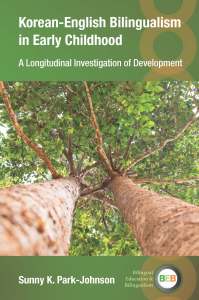This month we published Korean-English Bilingualism in Early Childhood by Sunny K. Park-Johnson. In this post the author explains the importance of the longitudinal nature of the study.
 When studying bilingual language development in early childhood, we often rely heavily on snapshots: these data come from just a day or two of their lives. Sometimes we see children in labs for a study, and then we never hear from them again. That is why a longitudinal study is so important. Following children’s language development across time gives us a perspective that is both expansive and specific, capturing moments in development that we sometimes miss in snapshots.
When studying bilingual language development in early childhood, we often rely heavily on snapshots: these data come from just a day or two of their lives. Sometimes we see children in labs for a study, and then we never hear from them again. That is why a longitudinal study is so important. Following children’s language development across time gives us a perspective that is both expansive and specific, capturing moments in development that we sometimes miss in snapshots.
This book does just that. We get to see two-and-a-half years’ worth of data, observed monthly, that provides a rich picture of four Korean-English bilingual children’s language journey. The children in this book are acquiring both Korean and English during early childhood, a rich time of language development that has many nuances, small changes, and subtle shifts. And because the data is collected in the child’s home, we’re able to capture naturalistic, spontaneous language “in the wild”.
The longitudinal study is also important because it compares children to themselves over time. We know there is much individual variation between children; by observing children’s development longitudinally, the comparisons are within the child’s own self. This inherent consistency is immensely valuable when studying the picture of children’s language development.
The book takes readers through the development of morphology and syntax of Korean and English separately, then discusses code-switching and interplay between the two languages. Then, as an epilogue of sorts, there is a chapter that reports on an interview with two of the children, who are now young adults. It is a unique experience to hear from the very same participants a decade later as they reflect back on their bilingualism and language journey.
Perhaps most importantly, as a Korean-English bilingual myself, I was welcomed into the lives of these families: not just as a researcher, but as an extended family member. Thus, the book has an insight, context, and weight that goes beyond grammar; it is imbued with the responsibility and care of an insider that understands and loves the community. The value of those relationships cannot be understated.
For more information about this book please see our website.
If you found this interesting, you might also like Multimodal Communication in Young Multilingual Children by Jieun Kiaer.